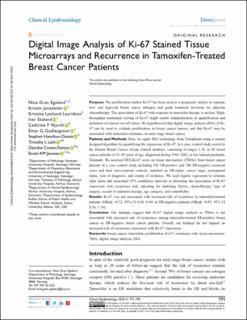| dc.description.abstract | Purpose: The proliferation marker Ki-67 has been used as a prognostic marker to separate low- and high-risk breast cancer subtypes and guide treatment decisions for adjuvant chemotherapy. The association of Ki-67 with response to tamoxifen therapy is unclear. High-throughput automated scoring of Ki-67 might enable standardization of quantification and definition of clinical cut-off values. We hypothesized that digital image analysis (DIA) of Ki-67 can be used to evaluate proliferation in breast cancer tumors, and that Ki-67 may be associated with tamoxifen resistance in early-stage breast cancer.
Patients and Methods: Here, we apply DIA technology from Visiopharm using a custom designed algorithm for quantifying the expression of Ki-67, in a case–control study nested in the Danish Breast Cancer Group clinical database, consisting of stages I, II, or III breast cancer patients of 35– 69 years of age, diagnosed during 1985– 2001, in the Jutland peninsula, Denmark. We assessed DIA-Ki-67 score on tissue microarrays (TMAs) from breast cancer patients in a case–control study including 541 ER-positive and 300 ER-negative recurrent cases and their non-recurrent controls, matched on ER-status, cancer stage, menopausal status, year of diagnosis, and county of residence. We used logistic regression to estimate odds ratios and associated 95% confidence intervals to determine the association of Ki-67 expression with recurrence risk, adjusting for matching factors, chemotherapy, type of surgery, receipt of radiation therapy, age category, and comorbidity.
Results: Ki-67 was not associated with increased risk of recurrence in tamoxifen-treated patients (ORadj =0.72, 95% CI 0.54, 0.96) or ER-negative patients (ORadj =0.85, 95% CI 0.54, 1.34).
Conclusion: Our findings suggest that Ki-67 digital image analysis in TMAs is not associated with increased risk of recurrence among tamoxifen-treated ER-positive breast cancer or ER-negative breast cancer patients. Overall, our findings do not support an increased risk of recurrence associated with Ki-67 expression. | en_US |

